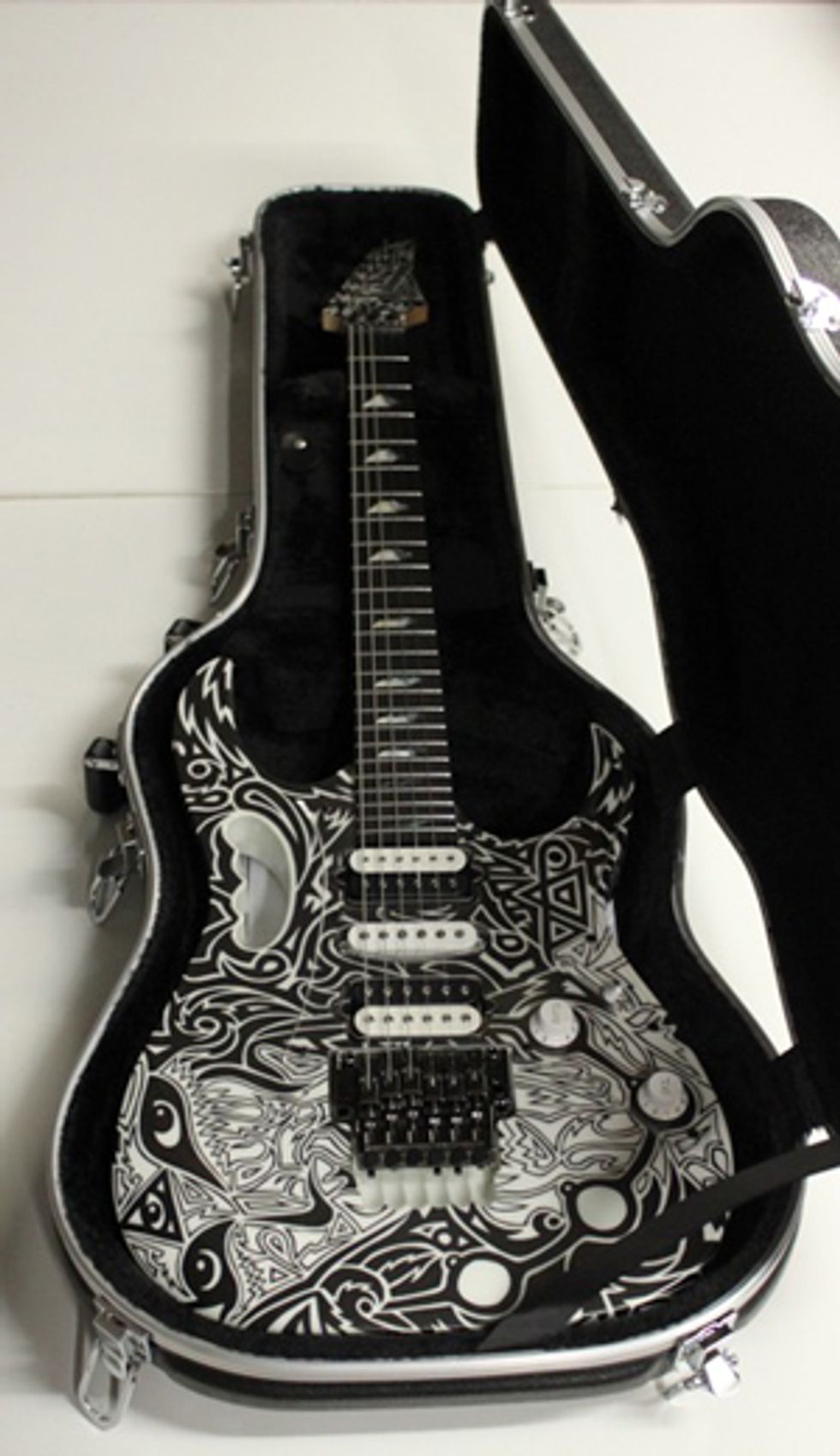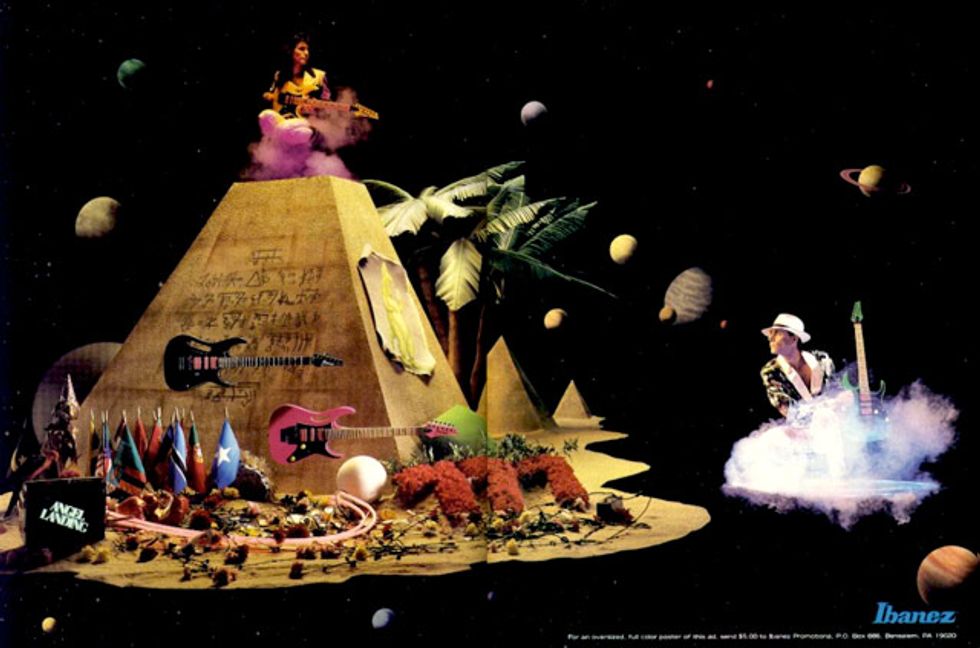There's a brilliant photo in the book, Ibanez: The Untold Story, of Kramer Guitars’ Dennis Berardi and colleagues at the Chicago NAMM show in 1987. Berardi appears spellbound as he looks intensely at something just outside of the frame. Meanwhile, one of his colleagues wears an expression of utter pain and bewilderment. The reason for these expressions was that Ibanez and Steve Vai had just unveiled the JEM, Vai's signature instrument, and in that exact moment the entire guitar landscape was reshaped. Ibanez was suddenly sitting atop a pyramid not unlike the one Vai himself was perched on in the “Angel Landing” advertisement subsequently used to promote the JEM.
There were probably many reasons the Kramer execs were so befuddled by the JEM. Certainly, securing Vai as an endorser was a huge coup. But the JEM was more than just a signature guitar for one of the most popular axemen in the world: It also incorporated many unique custom features, ones that weren’t common on large-scale production guitars up to that point, and certainly not in the “perfect storm” of high performance specs the JEM provided.
For starters, the JEM had three DiMarzio pickups (a pair of PAF Pro humbuckers and a JEM single-coil) wired in a then-unique arrangement where by the 2nd and 4th positions split the humbuckers into single-coils in combination with the middle pickup. This arrangement, pioneered by DiMarzio's Steve Blucher, allowed Vai to achieve Stratocaster-style in-between sounds as well as the humbucker raunch of the PAF Pro. There was also a high-pass filter on the volume control to help the guitar retain high end when the volume pot was rolled back.
It also featured a “bear claw” rout behind the Ibanez Edge locking vibrato bridge, inspired by the chiseled trench Vai had gouged into his Charvel “Green Meanie” guitar. This allowed him to achieve a much further range of upward motion than simply floating the tremolo at an angle off the body, and it made it easy to perform wild “flutter” effects.
A guitar with 24 frets was not unheard of before 1987, but this was still relatively uncommon. The last four frets were scalloped, allowing Vai and like-minded shredders to really lay into those high notes, and upper-fret access was enhanced by a crescent-shaped scoop around the neck joint area. The JEM also rocked some rather flashy cosmetic touches: three-color, disappearing-pyramid fretboard inlays (keen eyes would note that the green/pink/yellow pyramids echoed the three JEM colors available at launch); brightly colored pickups, knobs, pickup selector switch and tremolo rout; and of course, the “monkey grip” handle, which allowed Vai to pull off extra-flashy stage moves.
The JEM had a less showy but equally shred-worthy and innovative cousin, the Ibanez RG550. The 550 featured much of the same innovation as the JEM (HSH pickup layout with the same custom switching, 24 frets, crescent-carved neck joint; back-routed Edge cavity) but without some of the higher-cost additions such as the scalloping, the DiMarzio pickups, the six individual bear claw scoops, and the monkey grip.
While some JEMs have been modded over the years, the majority of owners tend to keep them in their original state. It's rare even to find a JEM with a pickup swap, so there isn't really a particular set of common JEM mods to speak about. However the RG550 and its stablemates make great starting points for fans to build their own custom JEM-style guitars. They're relatively inexpensive on the used market, and their modern-day equivalents (such as the RG2550) exhibit exceptional build quality. Anyone with a pin router, a steady hand and a lot of patience can add a monkey grip to their RG550. You can reshape the Edge rout into a bear claw with carving chisels and maybe a bit of wood filler to rectify the odd mistake. DiMarzio makes various Vai signature pickups (the Evolution, the Breed, the Evo 2, and the new Gravity Storm), which would likely get you closer to Vai's tonal mojo.
It's common for RG-to-Jem conversions to feature a variation on the multicolor swirl paint technique pioneered by Darren Johansen of About Time Designs and seen on various JEMs, as well as the 7-string counterpart, the Universe. Two of the most revered swirlers, Herc Fede and Out Of This Swirled, recently announced their respective retirement from the swirling biz, but there are many talented painters out there (Perle Guitars comes to mind) who offer swirls in every color. Rich Harris' Ibanez Rules is a prime location to purchase JEM-friendly parts, from vibrato arm socket holders to new-old-stock (NOS) pickguards and colored DiMarzios.

Another rare example of an actual modified JEM belongs to Dean Dynna of Canada. His 1991 JEM7PBK has been repainted with a green marbling effect on a black background, providing a slight thematic link to the swirled JEMs but maintaining the original black vibe of that stock model.
But as much fun as it is to upgrade an RG to near-JEM specs, there's still something magical about a true Ibanez JEM. There have been a few changes over the years, such as different body and fretboard woods, different pickups, a few rear-routed models with clear pickguards to showcase fabric finishes, a new neck joint and different fretboard inlays, etc. But a brand new JEM today bares much in common with its 1987 counterpart, and in many ways the JEM is still that same guitar that gave Kramer such a shock in Chicago 25 years ago.







![Rig Rundown: Russian Circles’ Mike Sullivan [2025]](https://www.premierguitar.com/media-library/youtube.jpg?id=62303631&width=1245&height=700&quality=70&coordinates=0%2C0%2C0%2C0)

















